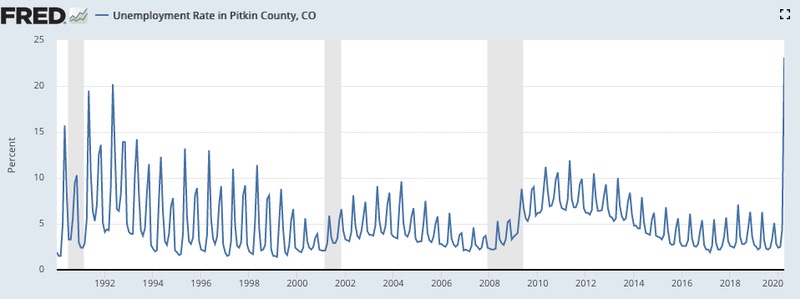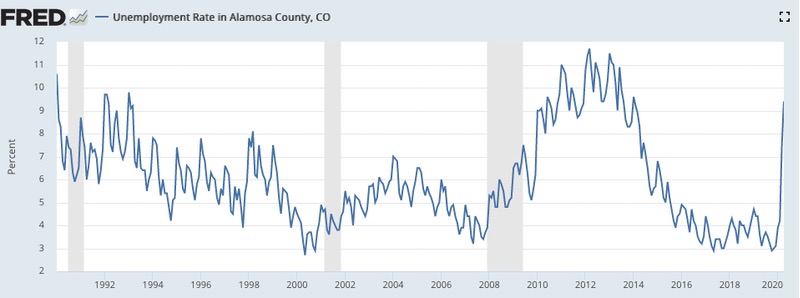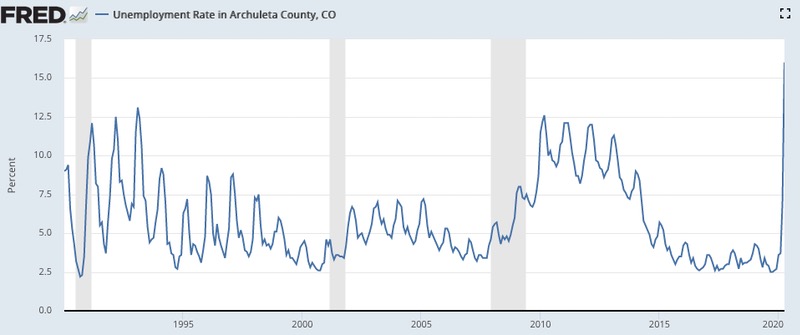Judging by the Town Council discussion on June 2, the Pagosa Springs Area Tourism Board and its staff are now hard at work “welcoming” summer tourists “back” to Pagosa Springs, albeit with a reduced marketing budget. The Board and its staff are funded through Lodgers Tax revenues, which are expected to be somewhat reduced this year. Maybe greatly reduced?
Sales tax revenues, meanwhile, seem to be holding steady, at least for the time being.
I was having coffee with a couple of friends recently, and the conversation drifted around to the current economic conditions in Pagosa Springs — as conversations are prone to do, these days. My two friends echoed the common belief that Pagosa Springs is greatly dependent upon tourism, and wondered how soon the tourists would return — if at all.
But we don’t actually have a tourism economy, I suggested.
They both looked somewhat shocked at this suggestion.
What we have is actually a retirement economy, I explained. The amount of money coming into the community from tourists is less important than the money flowing into the economy from the pensions of folks who moved here, following their retirement.
My friends looked skeptical. And to be honest, I have only limited pieces of evidence for making such a claim.
The average household income, for example, compared to the average wages paid by the tourism industry.
The average age of 50 in Archuleta County, compared to Colorado’s average age of 36.
The median home prices.
Pieces of evidence that the Pagosa Springs economy draws most of its dollars from people who live here, rather than from visitors.
Can we find any evidence for this claim — that we’re actually a ‘retirement economy’ — in the midst of a global pandemic? The current social tsunami has exposed some of the underlying machinery of modern society, and in particular, the workings of the Pagosa Springs economy. If we dare examine the wound…
Here’s a chart showing the unemployment trends in Denver since 1990, as graphed by the Federal Reserve Bank. The grayshaded bars indicate three recent recessions: The Oil Price Shock during the early 1990s, the DotCom Bubble-9/11 recession of 2001, and the Great Recession of 2007-2009. The annual high points on the graph show the city’s economy slowing down each year, January-March.
Prior to the COVID crisis, the most recent unemployment peak was in March 2010, about about 10 percent. As we note, the unemployment rate skyrocketed during March, the final month included on this graph, hitting 13.2 percent. This is no surprise to anyone. The US as a whole lost 24 million jobs in March, due to the COVID pandemic and the resulting shutdowns.
Still, for an economy as diverse as Denver’s, the March 2020 spike is probably unprecedented.
Next is the graph for Pitkin County, home to Aspen, one of the nation’s premiere ski destinations, where annual unemployment bounces up and down dramatically with the highest peaks in May — following the ski season — and November — just prior to ski season. Prior to the current virus shutdown, the most recent unemployment peak happened in May 2011, hitting 12 percent.
This graph hints at the annual boom-and-bust cycles typical to town that’s built its economy upon tourists. We will also note that the COVID crash hit Aspen employees quite a bit harder than Denver workers. Aspen’s unemployment rate at the end of March was 23.1 — almost twice the rate seen in Denver.
The next chart shows the unemployment trends in Alamosa County — a place that sees very little tourism, compared to Denver and Aspen. Once again, annual unemployment hits its highest points each year during January-March. The high point during the Great Recession was in March 2012, hitting almost 12 percent — roughly the same as in Aspen.
But the graph looks very different from the Aspen graph, because the March 2020 COVID spike didn’t even hit the high point of the Great Recession. Again, we see a sudden unemployment spike in March — but not near the spike we saw in Denver or Aspen. In Alamosa, the COVID peak was 9.4 percent.
Denver, 13.2 percent. Aspen, 23.1 percent.
Which leads us finally to unemployment in Archuleta County, supposed tourist town. Our Great Recession peak came in March 2010, at about 12.5 percent. Our unemployment in March 2020 — 16 percent — was considerably closer to diverse Denver than to tourism-dependent Aspen.
Many people feel pretty sure we’re a ski town in the winter, being a mere 20 miles from Wolf Creek Ski Area. Kinda like Aspen? But in fact, all of the unemployment peaks since 1990 have happened between January-March each year.
Clearly, our experience with unemployment during the COVID crisis was far more dramatic — in March, this year — than what was seen in Alamosa, and slightly more dramatic than what Denver saw… but not too terribly close to what they experienced in Aspen.
This data might suggest that the Pagosa Springs economy is somewhat tourism-dependent, but also somewhat resilient compared to an authentic “Colorado mountain resort town” like Aspen.
Resiliency. That’s an idea I can get behind. Building a resilient community, if we could figure out how to do a better job of that, seems to me a better approach to economic health and social well-being than “Endless Growth.”
You can readily connect that idea — resiliency — with a well-known proverb. “Don’t put all your eggs in one basket.”
I wish our governments here would make more of an effort to fill the various baskets that make for a healthy, diverse community. But what I hear, all too often, is that we have a tourism economy… and we need more tourists. And we need more “growth.” I don’t believe that’s an ideal approach. I believe we have a retirement economy, or maybe a retirement-recreation economy, and we could embrace what we are, and fix the leaks, and become stronger rather than more fragile.
Maybe, if the tourists don’t return this year, we will find out more about our level of resiliency.




